
Pellegrino Tibaldi, also known as Pellegrino di Tibaldo de Pellegrini, was an Italian mannerist architect, sculptor, and mural painter.
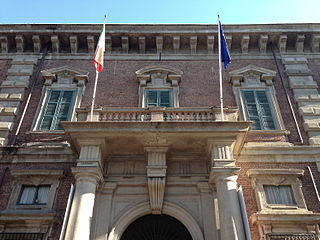
Palazzo Brera or Palazzo di Brera is a monumental palace in Milan, in Lombardy in northern Italy. It was a Jesuit college for two hundred years. It now houses several cultural institutions including the Accademia di Brera, the art academy of the city, and its gallery, the Pinacoteca di Brera; the Orto Botanico di Brera, a botanical garden; an observatory, the Osservatorio Astronomico di Brera; the Istituto Lombardo Accademia di Scienze e Lettere, a learned society; and an important library, the Biblioteca di Brera.

Brianza is a geographical, historical and cultural area of Italy, at the foot of the Alps, in the northwest of Lombardy, between Milan and Lake Como.

The Palazzo Litta, also known as the Palazzo Arese-Litta, is a Baroque structure in Milan, northern Italy, opposite San Maurizio al Monastero Maggiore, and dating from the period of Spanish rule of the city. In 2018, it served as a cultural center, housing exhibition spaces, offices, and a theater.

Visconti Park was the private park of the Visconti and Sforza families, lords, and dukes of Milan. Located in Lombardy, northern Italy, it extended between the Pavia Castle and the Pavia Charterhouse. It covered an area of about 2,200 hectares (22 km2) and was encircled by walls about 25 kilometres (16 mi) in length. It was founded in 1360 by Galeazzo II Visconti and enlarged by his son Gian Galeazzo. Its decay began in 1525 with the damages inflicted during the Battle of Pavia. Today, the park's area mainly serves agriculture purposes, while some portions are nature reserves.

Characteristic of the historic center of Pavia is the presence of medieval noble towers that survive in its urban fabric, despite having once been more numerous, as evidenced by the sixteenth-century representation of the city frescoed in the church of San Teodoro. They were mostly built between the 11th and 13th centuries when the Ghibelline city was at the height of its Romanesque flowering.

The Broletto or Broletto Palace of Pavia, Italy has for centuries housed the civic government offices of this city found in the region of Lombardy, Italy. The term Broletto refers to a buildings equivalent to the town hall or town assembly.
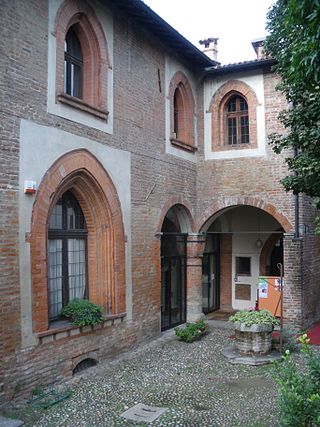
The Casa degli Eustachi is a medieval palace in Pavia in Lombardy.

The Old Campus of the University of Pavia is a complex located in Pavia, in Lombardy, home to the rectorate and some university faculties and the University History Museum of the University of Pavia.

Palazzo Mezzabarba is a palace in Pavia, Lombardy, a notable example of Lombard rococo, It has been Pavia's city hall since 1875.

The monastery of Santa Maria Teodote, also known as Santa Maria della Pusterla, was one of the oldest and most important female monasteries in Pavia, Lombardy, now Italy. Founded in the seventh century, it stood in the place where the diocesan seminary is located and was suppressed in the eighteenth century.

The Palazzo Botta or Botta Adorno is a Neoclassical-style palace with a long facade along Via Lanfranco and Piazza Botta Adorno Antoniotto in the town of Pavia, region of Lombardy, Italy. Once the family home of the aristocratic Botta family, it presently houses the Natural History Museum of Pavia and the Museum Camillo Golgi.

Palazzo Cornazzani is a palace in Pavia, in Lombardy, where, between 1895 and 1896, Albert Einstein lived.
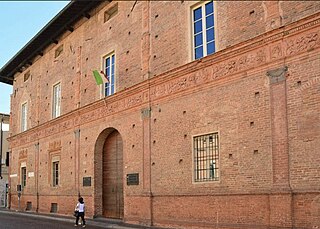
Palace Carminali Bottigella is a noble palace built by the ancient Beccaria family from Pavia. The original structure from the Sforza era was built between 1490 and 1499. The façade, which retains the original terracotta decorations, is one of the major examples of Renaissance civil building in Pavia.

The Palazzo Bellisomi Vistarino is an 18th-century palace in the city of Pavia and among the most important examples of Lombard rococo.

The Church of San Lazzaro is located on the eastern suburbs of Pavia. Built in the 12th century along the Via Francigena, it was equipped with a hospital dedicated to the care of pilgrims and lepers.
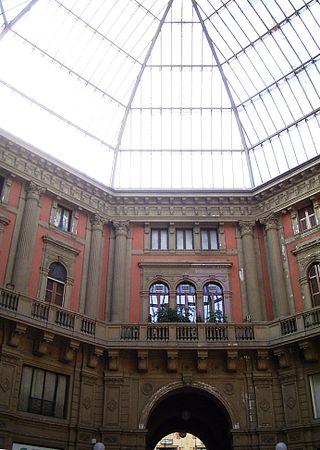
Galleria Arnaboldi is a shopping arcade in Pavia, in Lombardy, which, in the form of a covered pedestrian street, connects Strada Nuova to Piazza del Lino.

The Casa dei Grifi is a historic building in Milan, located in Via Valpetrosa 5.
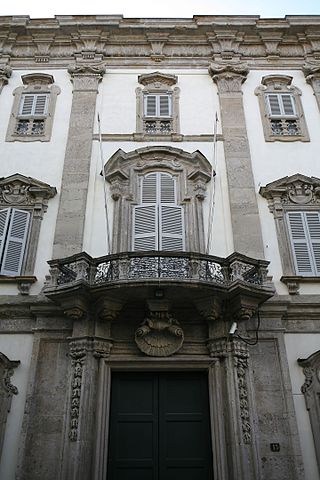
Palazzo Cusani is a 17th-century palace in Milano, remodelled a first time between 1712 and 1719 and a second time between 1775 and 1779. Historically belonging to the sestiere of Porta Nuova, it is located at via Brera 13–15.






















